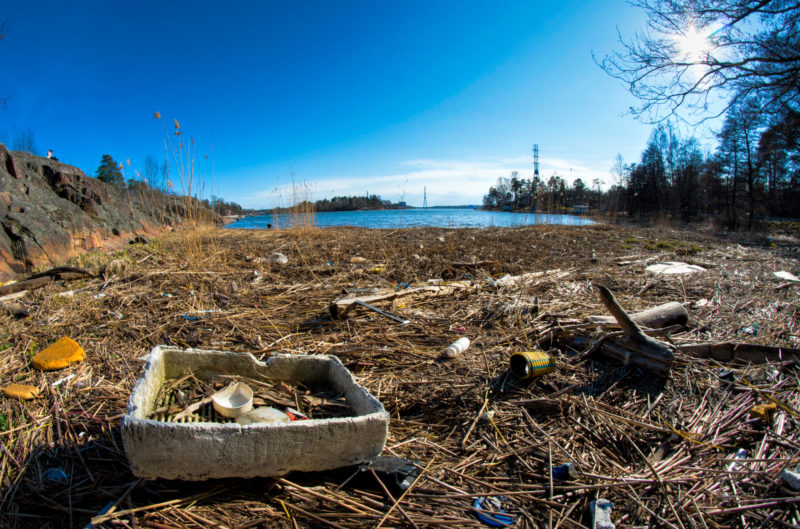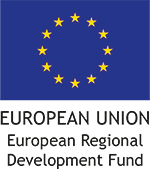What is marine litter?
Common types of marine litter
Degradation of plastic is slow
CORNER: Microplastics
References
What is marine litter?
Items with anthropogenic origin become litter when they enter the environment: marine litter is defined as ”any persistent, manufactured or processed solid material discarded, disposed of or abandoned in the marine and coastal environment” by UNEP (United Nations Environment Programme). Anthropogenic litter, especially plastic, has been increasing in oceans over the last decades and can be nowadays found on six distinct compartments: sea surface, water column, coastlines, seafloor, sea ice and biota.
Marine litter consists of various materials including for example glass, metal, plastics, ceramics, rubber, paper and machined wood. The largest proportion of all marine litter is plastics, accounting for up to 95 % of all debris in some areas. The continuously increasing global production of plastics and poor management practices has led to their accumulation in the oceans, and since their degradation may last even hundreds of years they are really persistent in the marine environment. Even though further accumulation of plastic litter into the ocean could be prevented, degradation of the litter already present in the marine environment may last a lifetime.
Plastic litter found floating on the sea surface or stranded on the beaches is seldom classified according to the plastic type; rather the classification is done by geometry (e.g. fibre, sphere and fragment) or by product type (e.g. drinking bottle, cigarette butt and straw). In addition, plastic litter is also categorized by size into different size classes: megaplastic (> 100 mm), macroplastic (> 20 mm), mesoplastic (5–20 mm), microplastics (< 5 mm) and nanoplastics (< 100 nm). There is some variation in exact definitions of different size classes, and usually the distinction is only made between microplastics (< 5 mm) and larger plastics (> 5 mm) grouped together to macro-sized plastics.
So far most of the research on plastic litter has focused on macroplastics followed by increasing studies about microplastics. The smaller the particle is, the harder it is to detect in the marine environment. Therefore, less is known about the tiniest microplastics and nanoplastics. However, nanoplastics are suggested being potentially the most hazardous plastic size class, but more information is definitely needed to evaluate their potential impacts.
 Humallahti beach is one of the most littered beaches in Helsinki. Photo: Tuomas Lahti
Humallahti beach is one of the most littered beaches in Helsinki. Photo: Tuomas Lahti
Common types of marine litter
When studying the composition of marine litter, results may vary depending on the sampled media, sampling method and location. The majority of anthropogenic litter on beaches and in coastal waters are plastic, and especially Styrofoam seems to be common in many areas. Plastics with low density, such as polyethylene (PE) and polypropylene (PP), and air-trapping items, such as bottles, typically float in the water and are thus commonly found on the sea surface and on the beaches. Materials with higher density are often found submerged in the water column or sunken on the seafloor.
In general, the mass of macroplastics outnumbers the mass of microplastics present in the world’s oceans, but microplastics are more numerous: it has been estimated that they might account for 92.4 % of all the plastic pieces floating in the marine environment. Secondary microplastics are observed to be more common compared to primary microplastics, and their amount in the marine ecosystems is expected to rise because of the on-going degradation of larger litter in the environment.
KNOWLEDGE CORNER
MICROPLASTICS
Microplastics are usually invisible for the naked eye – they include all plastic particles less than 5 mm in diameter. Microplastics can be divided into two categories: they are considered being primary if they are originally manufactured to be small and secondary if they have been fragmented from larger plastic items. Primary microplastics include for example virgin resin pellets, industrial scrubbers used to blast clean surfaces and small microbeads present in some cosmetic products. There is an enormous variety in secondary microplastics, since they can originate from the breakdown of any larger plastic item. Like all plastic debris, microplastics have spread all around the globe from poles to equator and from the sea surface to the deep sea. Microplastics are of a particular concern, since there are no way to remove them from the marine environment due to their small size, chemical inertness, vast distribution and similar dimension as for example plankton and fish eggs.
An international coastal cleanup day arranged by Marine Conservancy in 2015 engaged a huge number of organizations and volunteers around the globe to remove trash from the world’s beaches and waterways. This cleanup produced valuable information about the most numerous macro-sized litter items on coastlines globally, which mostly consisted of consumer plastics. The knowledge on the composition of marine litter in different locations is helpful when assessing the sources of litter and planning suitable reduction measures.
Most common debris collected from the world’s coastlines and waterways during the international coastal cleanup in 2015
| Rank | Item | Count | Plastic type usually used in the items |
| 1 | Cigarette butts | 2 127 565 | Cellulose acetate (CA) |
| 2 | Plastic beverage bottles | 1 024 470 | Polyethylene terephthalate (PET) |
| 3 | Food wrappers | 888 589 | Polyethylene (PE), polypropylene (PP) |
| 4 | Plastic bottle caps | 861 340 | Polyethylene (PE), polypropylene (PP) |
| 5 | Straws, stirrers | 439 571 | Polyethylene (PE) |
| 6 | Other plastic bags | 424 934 | Polyethylene (PE) |
| 7 | Glass beverage bottles | 402 375 | – |
| 8 | Plastic grocery bags | 402 122 | Polyethylene (PE) |
| 9 | Metal bottle caps | 381 669 | – |
| 10 | Plastic lids | 351 585 | Polyethylene (PE), polypropylene (PP) |
However, the results obtained from coastal cleanups do not provide a full picture about the composition of marine litter. Cleanups are often conducted in densely populated areas and mainly on the beaches, which are easily accessible and do not require any special equipment. The litter composition varies between location reflecting the human activities, such as shipping, fishing and tourism, on the coast. For example on European seafloors fishing related litter is observed being most common in some areas. Additionally, cleanups usually concentrate on macro-sized litter and fail to detect microplastics due to their small size.
degradation of plastic is slow
Even though plastics are very durable, they will eventually undergo degradation and experience partial or complete breakdown of the polymer. The factors that influence the weathering and degradation of plastic polymer structure include the chemical environment, heat, UV radiation and high-energy radiation. The weathering process is also depended on the polymer and additive types which have different responses to above-mentioned factors, and this results in very specific weathering patterns in different plastics.
The major degrading processes of plastics in marine environment are solar UV-induced photodegradation reactions and thermal reactions including thermo-oxidation. The photo-oxidative reactions initiated by UV-radiation lead in incorporation of oxygen-containing functionalities into the polymer molecules. In addition it induces scission of polymer molecules, which alters the polymer properties such as weakens the mechanical strength. Even though especially UV-B radiation (290–315 nm) is particularly efficient in facilitating photodegradation due to its short wavelength and high energy content, larger fraction of the solar spectrum consists of longer wavelengths. Therefore, most light-induced damage is induced by visible light (380–700 nm) and nearby regions in the spectrum, such as UV-A radiation (315–380 nm).
Light-induced degradation rates increase with rising temperature; therefore, photodegradation can be aided by slowly occurring thermo-oxidation in suitable conditions. Temperature affects the weathering behaviour of different coloured plastics as well: dark coloured plastics absorb more of the energy from the sunlight than lighter coloured particles and hence tend to weather faster.
The weathering under marine conditions differ greatly in comparison to conditions on land because of differences in key environmental parameters such as temperature and exposure to sunlight. In general, weathering occurs significantly slower in marine environment due to lower temperature and attenuation of solar radiation with increasing depth. Once plastic sinks beyond the photic zone, the degradation is affected by neither light- or temperature-induced processes. If plastic is floating, only light-induced oxidative degradation is effective. On beaches photodegradation can be aided by slowly occurring thermo-oxidation and with physical processes such as saltation and traction.
Also biological factors can contribute to the weathering behaviour of floating and beached plastics. Plastic debris can be colonized by various micro-organisms, which are said to generate a biofilm around the item. This microbial biofilm can further stimulate the attachment of small invertebrates. The biofilm and fouling organisms on the plastic surface are suggested to reduce degradation since they absorb the solar radiation and prevent the light from reaching the plastic.
When plastic starts to weather due to UV and thermal exposure, alterations in the structure of the material occurs: the molecular weight decreases, mechanical properties such as tensile strength changes and the surface becomes discolorised and can experience micro-cracking or chalking. Chalking is a process where plastic is turning whitish as the fillers are released from the plastic matrix. When cracking, small fissures are observed to first appear on the edges and then spread towards the centre. Weathering has been studied for example with virgin plastic pellets, which are observed to turn yellowish with prolonged environmental exposure. Also an increase in opacity and brittleness were detected.
Micro-cracking and embrittlement of the plastic surface enables the fragmentation of secondary microplastics from larger plastic items. Some additives used in plastic production may also contribute to the generating of microplastics: sometimes polyethylene (PE) is manufactured with a metal-based additive that results in faster fragmentation of plastic. It must be noted, however, that this degradation does not mean that the plastic slowly disappears – it just fragments into smaller pieces, which can be as persistent in the environment as the larger plastic items.
Further degradation is performed by microbes and termed biodegradation, which results in the breakdown of the material to naturally occurring compounds such as carbon dioxide and water. The properties of plastics affect their degradation: for example plastics with high molecular weight, high melting temperature and high degree of crystallinity are harder to biodegrade. However, biodegradation is the only mechanism that truly removes plastic polymers from the environment and while micro-organisms capable to degrade plastics exist in the oceans, the rate of these processes is far too slow to remove plastic from the environment. Therefore, a significant biodegradation of plastic is presumably not happening in the oceans.

